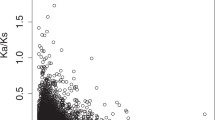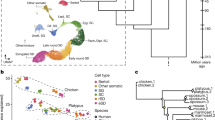Abstract
We compared the human and mouse X chromosomes to systematically test Ohno's law, which states that the gene content of X chromosomes is conserved across placental mammals1. First, we improved the accuracy of the human X-chromosome reference sequence through single-haplotype sequencing of ampliconic regions. The new sequence closed gaps in the reference sequence, corrected previously misassembled regions and identified new palindromic amplicons. Our subsequent analysis led us to conclude that the evolution of human and mouse X chromosomes was bimodal. In accord with Ohno's law, 94–95% of X-linked single-copy genes are shared by humans and mice; most are expressed in both sexes. Notably, most X-ampliconic genes are exceptions to Ohno's law: only 31% of human and 22% of mouse X-ampliconic genes had orthologs in the other species. X-ampliconic genes are expressed predominantly in testicular germ cells, and many were independently acquired since divergence from the common ancestor of humans and mice, specializing portions of their X chromosomes for sperm production.
This is a preview of subscription content, access via your institution
Access options
Subscribe to this journal
Receive 12 print issues and online access
$209.00 per year
only $17.42 per issue
Buy this article
- Purchase on Springer Link
- Instant access to full article PDF
Prices may be subject to local taxes which are calculated during checkout



Similar content being viewed by others
References
Ohno, S. Sex Chromosomes and Sex-Linked Genes (Springer, Berlin, 1967).
Kuroiwa, A. et al. Conservation of the rat X chromosome gene order in rodent species. Chromosome Res. 9, 61–67 (2001).
Delgado, C.L., Waters, P.D., Gilbert, C., Robinson, T.J. & Graves, J.A. Physical mapping of the elephant X chromosome: conservation of gene order over 105 million years. Chromosome Res. 17, 917–926 (2009).
Prakash, B., Kuosku, V., Olsaker, I., Gustavsson, I. & Chowdhary, B.P. Comparative FISH mapping of bovine cosmids to reindeer chromosomes demonstrates conservation of the X-chromosome. Chromosome Res. 4, 214–217 (1996).
Ross, M.T. et al. The DNA sequence of the human X chromosome. Nature 434, 325–337 (2005).
Veyrunes, F. et al. Bird-like sex chromosomes of platypus imply recent origin of mammal sex chromosomes. Genome Res. 18, 965–973 (2008).
Watanabe, T.K. et al. A radiation hybrid map of the rat genome containing 5,255 markers. Nat. Genet. 22, 27–36 (1999).
Raudsepp, T. et al. Exceptional conservation of horse-human gene order on X chromosome revealed by high-resolution radiation hybrid mapping. Proc. Natl. Acad. Sci. USA 101, 2386–2391 (2004).
Band, M.R. et al. An ordered comparative map of the cattle and human genomes. Genome Res. 10, 1359–1368 (2000).
Murphy, W.J., Sun, S., Chen, Z.Q., Pecon-Slattery, J. & O'Brien, S.J. Extensive conservation of sex chromosome organization between cat and human revealed by parallel radiation hybrid mapping. Genome Res. 9, 1223–1230 (1999).
Spriggs, H.F. et al. Construction and integration of radiation-hybrid and cytogenetic maps of dog chromosome X. Mamm. Genome 14, 214–221 (2003).
Palmer, S., Perry, J. & Ashworth, A. A contravention of Ohno's law in mice. Nat. Genet. 10, 472–476 (1995).
Rugarli, E.I. et al. Different chromosomal localization of the Clcn4 gene in Mus spretus and C57BL/6J mice. Nat. Genet. 10, 466–471 (1995).
She, X. et al. Shotgun sequence assembly and recent segmental duplications within the human genome. Nature 431, 927–930 (2004).
Olivier, M. et al. A high-resolution radiation hybrid map of the human genome draft sequence. Science 291, 1298–1302 (2001).
Dietrich, W.F. et al. A comprehensive genetic map of the mouse genome. Nature 380, 149–152 (1996).
Church, D.M. et al. Lineage-specific biology revealed by a finished genome assembly of the mouse. PLoS Biol. 7, e1000112 (2009).
Tishkoff, S.A. & Kidd, K.K. Implications of biogeography of human populations for 'race' and medicine. Nat. Genet. 36, S21–S27 (2004).
Bovee, D. et al. Closing gaps in the human genome with fosmid resources generated from multiple individuals. Nat. Genet. 40, 96–101 (2008).
Kidd, J.M. et al. Mapping and sequencing of structural variation from eight human genomes. Nature 453, 56–64 (2008).
Skaletsky, H. et al. The male-specific region of the human Y chromosome is a mosaic of discrete sequence classes. Nature 423, 825–837 (2003).
Hughes, J.F. et al. Chimpanzee and human Y chromosomes are remarkably divergent in structure and gene content. Nature 463, 536–539 (2010).
Kuroda-Kawaguchi, T. et al. The AZFc region of the Y chromosome features massive palindromes and uniform recurrent deletions in infertile men. Nat. Genet. 29, 279–286 (2001).
Bellott, D.W. et al. Convergent evolution of chicken Z and human X chromosomes by expansion and gene acquisition. Nature 466, 612–616 (2010).
Lindblad-Toh, K. et al. Genome sequence, comparative analysis and haplotype structure of the domestic dog. Nature 438, 803–819 (2005).
Wade, C.M. et al. Genome sequence, comparative analysis, and population genetics of the domestic horse. Science 326, 865–867 (2009).
International Chicken Genome Sequencing Consortium. Sequence and comparative analysis of the chicken genome provide unique perspectives on vertebrate evolution. Nature 432, 695–716 (2004).
Wang, E.T. et al. Alternative isoform regulation in human tissue transcriptomes. Nature 456, 470–476 (2008).
Mortazavi, A., Williams, B.A., McCue, K., Schaeffer, L. & Wold, B. Mapping and quantifying mammalian transcriptomes by RNA-Seq. Nat. Methods 5, 621–628 (2008).
Bradley, R.K., Merkin, J., Lambert, N.J. & Burge, C.B. Alternative splicing of RNA triplets is often regulated and accelerates proteome evolution. PLoS Biol. 10, e1001229 (2012).
Handel, M.A. & Eppig, J.J. Sertoli cell differentiation in the testes of mice genetically deficient in germ cells. Biol. Reprod. 20, 1031–1038 (1979).
Mueller, J.L. et al. The mouse X chromosome is enriched for multicopy testis genes showing postmeiotic expression. Nat. Genet. 40, 794–799 (2008).
Coyne, J.A. & Orr, H.A. Speciation (Sinauer Associates, Sunderland, MA, 2004).
Elliott, R.W. et al. Genetic analysis of testis weight and fertility in an interspecies hybrid congenic strain for chromosome X. Mamm. Genome 12, 45–51 (2001).
Elliott, R.W., Poslinski, D., Tabaczynski, D., Hohman, C. & Pazik, J. Loci affecting male fertility in hybrids between Mus macedonicus and C57BL/6. Mamm. Genome 15, 704–710 (2004).
Storchová, R. et al. Genetic analysis of X-linked hybrid sterility in the house mouse. Mamm. Genome 15, 515–524 (2004).
Fujita, P.A. et al. The UCSC Genome Browser database: update 2011. Nucleic Acids Res. 39, D876–D882 (2011).
Schwartz, S. et al. Human-mouse alignments with BLASTZ. Genome Res. 13, 103–107 (2003).
Bailey, J.A. et al. Recent segmental duplications in the human genome. Science 297, 1003–1007 (2002).
Osoegawa, K. et al. A bacterial artificial chromosome library for sequencing the complete human genome. Genome Res. 11, 483–496 (2001).
Salido, E.C. et al. Cloning and expression of the mouse pseudoautosomal steroid sulphatase gene (Sts). Nat. Genet. 13, 83–86 (1996).
Yeh, R.F., Lim, L.P. & Burge, C.B. Computational inference of homologous gene structures in the human genome. Genome Res. 11, 803–816 (2001).
Altschul, S.F., Gish, W., Miller, W., Myers, E.W. & Lipman, D.J. Basic local alignment search tool. J. Mol. Biol. 215, 403–410 (1990).
Thornton, K. & Long, M. Rapid divergence of gene duplicates on the Drosophila melanogaster X chromosome. Mol. Biol. Evol. 19, 918–925 (2002).
Trapnell, C., Pachter, L. & Salzberg, S.L. TopHat: discovering splice junctions with RNA-Seq. Bioinformatics 25, 1105–1111 (2009).
Trapnell, C. et al. Transcript assembly and quantification by RNA-Seq reveals unannotated transcripts and isoform switching during cell differentiation. Nat. Biotechnol. 28, 511–515 (2010).
Brawand, D. et al. The evolution of gene expression levels in mammalian organs. Nature 478, 343–348 (2011).
Deng, X. et al. Evidence for compensatory upregulation of expressed X-linked genes in mammals, Caenorhabditis elegans and Drosophila melanogaster. Nat. Genet. 43, 1179–1185 (2011).
Acknowledgements
We thank D. Albracht, J. Collins, M. Gill, N. Koutseva, C. Kremitzki, A. van der Veen and J. Wood for technical assistance and D. Bellott, R. Desgraz, G. Dokshin, T. Endo, A. Godfrey, Y. Hu, J. Hughes, M. Kojima, B. Lesch, L. Okumura, K. Romer and Y. Soh for comments on the manuscript. This work was supported by the US National Institutes of Health and the Howard Hughes Medical Institute.
Author information
Authors and Affiliations
Contributions
J.L.M., H.S., W.C.W., R.K.W. and D.C.P. planned the project. J.L.M. and L.G.B. performed BAC mapping. J.L.M. performed RNA deep sequencing. T.G., S.R., K.A. and S.Z. were responsible for finished BAC sequencing. J.L.M. and H.S. performed sequence analyses. J.L.M. and D.C.P. wrote the manuscript.
Corresponding author
Ethics declarations
Competing interests
The authors declare no competing financial interests.
Supplementary information
Supplementary Text and Figures
Supplementary Note, Supplementary Figures 1–6 and Supplementary Tables 1, 5 and 9 (PDF 5830 kb)
Supplementary Table 2
Genes shared between human and mouse X chromosomes (XLS 155 kb)
Supplementary Table 3
Human X-linked genes with no detectable ortholog on the mouse X chromosome (XLS 53 kb)
Supplementary Table 4
Mouse X-linked genes with no detectable ortholog on the human X chromosome (XLS 62 kb)
Supplementary Table 6
Tissue expression of X-linked genes shared between human and mouse (XLS 239 kb)
Supplementary Table 7
Expression patterns of independently acquired human X-linked genes (XLS 52 kb)
Supplementary Table 8
Expression patterns of independently acquired mouse X-linked genes (XLS 57 kb)
Supplementary Table 10
Expression patterns of all human autosomal genes (XLS 3622 kb)
Supplementary Table 11
Expression patterns of all mouse autosomal genes (XLS 2626 kb)
Supplementary Table 12
All OMIM X-linked phenotypes where the molecular basis is known (XLS 62 kb)
Supplementary Table 13
Expression patterns between the sexes, in the heart and kidney, of human genes that follow Ohno's law (XLSX 60 kb)
Supplementary Table 14
Expression patterns between the sexes, in the heart and kidney, of mouse genes that follow Ohno's law (XLSX 65 kb)
Rights and permissions
About this article
Cite this article
Mueller, J., Skaletsky, H., Brown, L. et al. Independent specialization of the human and mouse X chromosomes for the male germ line. Nat Genet 45, 1083–1087 (2013). https://doi.org/10.1038/ng.2705
Received:
Accepted:
Published:
Issue Date:
DOI: https://doi.org/10.1038/ng.2705
This article is cited by
-
Sequence level genome-wide associations for bull production and fertility traits in tropically adapted bulls
BMC Genomics (2023)
-
RNA stability controlled by m6A methylation contributes to X-to-autosome dosage compensation in mammals
Nature Structural & Molecular Biology (2023)
-
Trio-binning of a hinny refines the comparative organization of the horse and donkey X chromosomes and reveals novel species-specific features
Scientific Reports (2023)
-
Eighty million years of rapid evolution of the primate Y chromosome
Nature Ecology & Evolution (2023)
-
High male specific contribution of the X-chromosome to individual global recombination rate in dairy cattle
BMC Genomics (2022)



